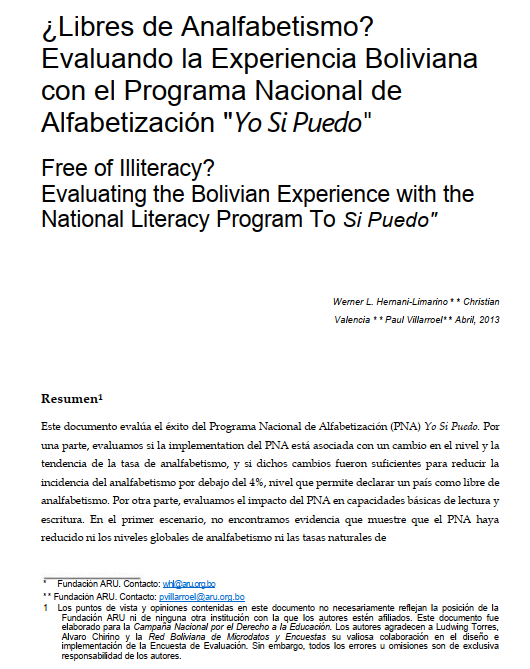Free of Illiteracy? Evaluating the Bolivian Experience with the National Literacy Program "I Yes I Can"
DOI:
https://doi.org/10.35319/lajed.20150376Keywords:
Impact evaluation, literacy programs, educationAbstract
This paper evaluates the success of National Literacy Program (PNA) "Yo Sí Puedo". First, we evaluate whether the implementation of PNA is associated with a change in the level and trend racy and if such changes were sufficient to reduce the incidence of illiteracy below 4%, which permits declare a country free of illiteracy. Moreover, we evaluate the impact of n basic reading and writing skills. In the first scenario, we found no evidence to show that PNA has reduced levels of illiteracy and natural rates of illiteracy reduction except for women in areas. In the second scenario, estimates show that PNA impact is quantitatively small but statistically significant on mechanical reading skills, statistically not different from zero on two reading comprehension outcomes, and quantitatively small but statistically significant on written communication skills. While our results are inconsistent with official statements declare Bolivia as free of illiteracy, they are consistent with other evaluations showing the ineffectiveness and inefficiency of adult literacy programs.
Downloads
References
Abadie,A. and G. Imbens (2002). Simple and bias-corrected rnatching estimatorsfor average treatment effects. National Bureau of Economic Research.
Abadie, A. and G. Imbens (2008). Bias Corrected Matching Estimators for Average Treatment Effects. Unpublish manuscript, Harvard University.
Abadzi, H. (1994). What we know about acquisition of adult literacy: is there hope?. Taylor & Francis.
Abadzi, H. (2003). lmproving adult literacy outcomes: lessons from cognitive research for developing countries. World Bank Publications.
Canavire, VB. (20 l l). Educación para adultos en América Latina: programa de alfabetización Yo, S 't Puedo ". Instituto de Investigaciones en Educación de la Universidad Veracruzana.
Canfux, J. and Liendo, T. (2008). Evaluación Del Impacto Del Programa Nacional de Alfabetización de Bolivia. Instituto Internacional de Investigación Educativa para la Integración Convenio Andrés Bello Ministerio de Educación y Cultura de Bolivia, Editorial Campos iris, La Paz, Bolivia.
Canfux, J., Liendo, T. and Mora, D., (2008). Experiencias sobre el Programa Nacional de Alfabetización en Bolivia. Instituto Internacional de Investigación Educativa para la Integración Convenio Andrés Bello Ministerio de Educación y Cultura de Bolivia, La Paz, Bolivia
Chowdhury, K.P and World Bank.(1995).Literacy and primary education. World Bank, Human Resources Development and Operations Policy.
República de Bolivia.(2006). Decreto Supremo No 28675.
Horvitz, D., and D.Thompson (1952).A genralization of Sampling Without Replacement from a Finite Universe, Journal of the American Statistical Association,47,663-685.
lmbens, Guido and Jeffrey Wooldridge (2008). Recent Developments in the Econometrics of Program Evaluation IZA Discussion Paper NO.3640.
Mora, D.and Canfux, J. (2009).Alfabetización y Emancipación. Memorias y reflexiones sobre el proceso de la alfabetización en Bolivia. Instituto Internacional de Investigación Educativa para la Integración Convenio Andrés Bello Ministerio de Educación y Cultura de Bolivia, Editorial Ipasme, La Paz, Bolivia
Neijs, K. ( 1961). Las cartillas de alfabetización: Preparación, evaluación y empleo, Unesco.
Ortega, D. and Rodríguez, F. and Miguel, E. (2006). Freed from illiteracy? Acloser look at Venezuelas Robinson Literacy Campaign Wesleyan Economics Working Papers
Romain, R.I. and Amstrong, L.A. (1987). Review of World Bank operations in nonformal education and training, World Bank, Education and Training Dept., Policy Division.
Weisbort, M. and Rosnick, D. (2008). Illiteracy Revisted: What Ortega and Rodríguez Read in the Household Survey, Center for Economic and Policy Research (CEPR)
Schaffner, J. (2005). Subjective and objetive measures of literacy: implications for current results-oriented development initiatives, International Journal of Educational Development
Rubin, D.(1973). The use of Matched Sampling and Regression Adjustments to Remove Bias in Observational Studies, Biometrics, 29, 185-203
Rubin D. (2006). Matched Sampling for Casual Effects, Cambridge University Press, Cambridge, UK.
Wooldridge, J. (2007). Inverse Probability Weighted M-Estimators for General Missing Data Problems, Journal of Econometrics.






